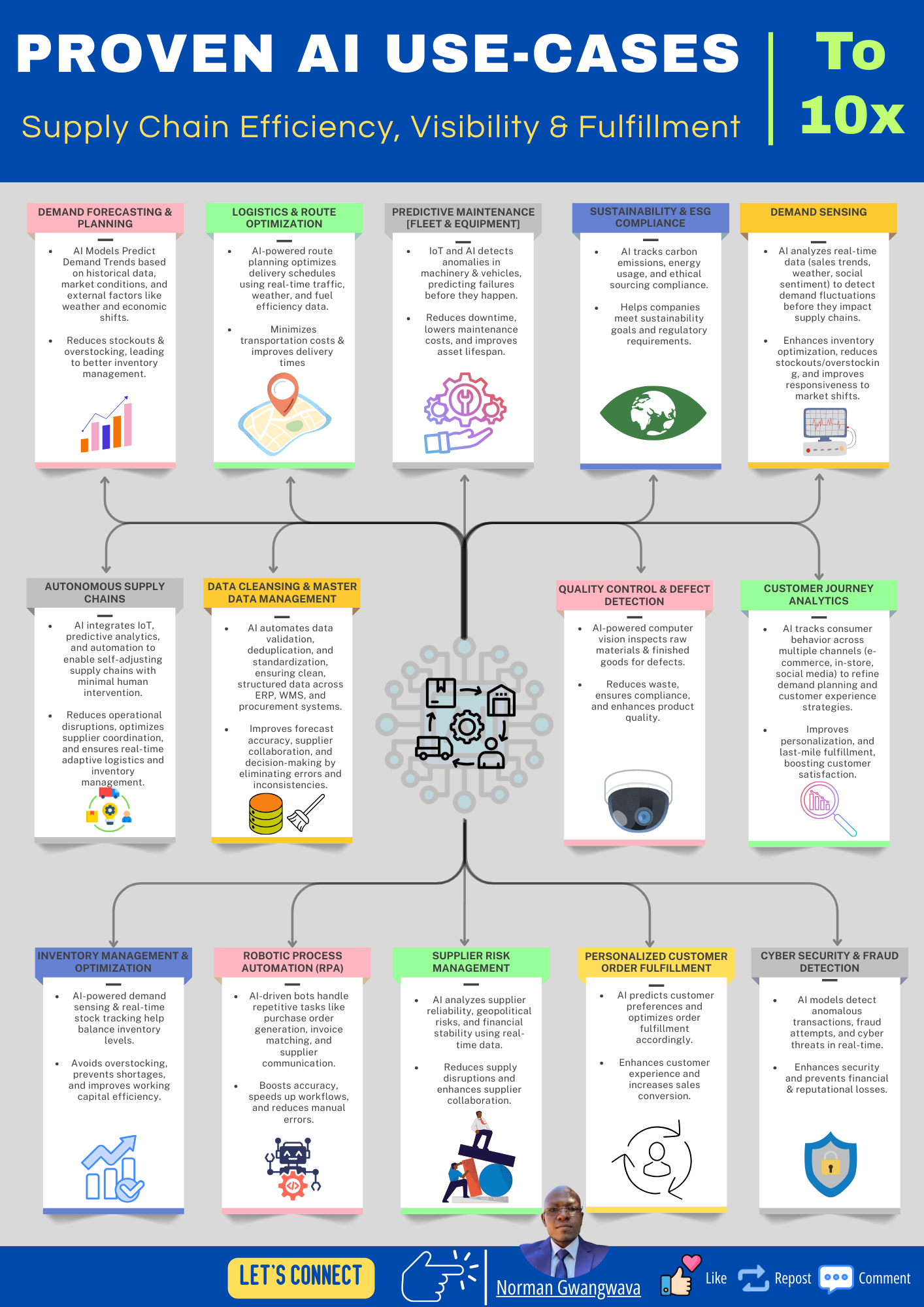10X Supply Chain Efficiency, Visibility & Fulfillment
Proven AI Use-Cases Used by Industry Leaders in 2025
If you're still relying on spreadsheets, reactive logistics, and siloed data—your supply chain is already behind.
In 2025, the most resilient, scalable, and profitable supply chains are powered by AI. And they don’t just predict what’s next—they respond, adapt, and optimize in real-time.
Whether you're a logistics leader, a tech builder, or just AI-curious, understanding where the technology is heading is no longer optional — it's mission-critical.
I've spent the last few years analyzing how enterprise leaders are adopting AI across global supply chain functions—from forecasting and procurement to last-mile delivery and ESG compliance.
What follows is a distilled visual guide to the most impactful, real-world AI use-cases transforming supply chains right now.
Why AI in Supply Chain Matters Right Now
In 2025, AI isn’t just being tested in labs or piloted in silos — it’s actively running the world’s largest supply networks. From Amazon’s predictive fulfillment to Tesla’s automated sourcing and Walmart’s last-mile logistics — intelligent systems are quietly transforming every node in the chain.
Today’s supply chains are complex ecosystems—global, volatile, and under pressure to be faster, leaner, and greener.
The opportunity? AI doesn’t just automate. It enables autonomous decision-making, predictive resilience, and hyper-personalized customer fulfillment—at scale.
To help you cut through the noise, I’ve created a visual guide of 15+ practical AI use-cases in supply chain — based on what’s working today.
👉 You can get the full resolution PDF file here: 🎁 Free bonus
Visual Breakdown: AI in Supply Chain — Use-Cases That Actually Matter
Here’s a breakdown of what top-performing organizations are prioritizing:
1. Demand Forecasting & Inventory Planning
What it does: Predicts product demand across geographies, seasons, and trends
Why it matters: Reduces overstock, stockouts, and working capital waste
Who's using it: Amazon, Walmart, Unilever
Tech stack: o9, Blue Yonder, Amazon Forecast
2. Predictive Maintenance (Fleet & Equipment)
What it does: Flags asset failures before they occur using sensor + AI data
Why it matters: Cuts downtime, saves millions in asset-related costs
Who's using it: Siemens, DHL, Caterpillar
Tech stack: IBM Maximo, Avathon
3. Route Optimization & Logistics AI
What it does: Real-time adjustments to route planning based on traffic, weather, fuel
Why it matters: Reduces delivery times, fuel spend, and customer SLA violations
Who's using it: Maersk, FedEx, Nestlé
Tech stack: FourKites, Project44
4. Supplier Risk Detection & Procurement AI
What it does: Monitors geopolitical, ESG, and credit risk across global supplier networks
Why it matters: Prevents disruptions and protects compliance
Who's using it: Apple, Boeing, Johnson & Johnson
Tech stack: Interos, Everstream Analytics
5. Warehouse & Fulfillment Automation
What it does: Uses AI + robotics to automate picking, packing, and sorting
Why it matters: Boosts order speed, accuracy, and scalability
Who's using it: Amazon, JD Logistics, Ocado
Tech stack: GreyOrange, Symbotic, Locus Robotics
6. RPA in Order-to-Cash / Procure-to-Pay
What it does: Automates invoice processing, purchase order matching, and contract handling
Why it matters: Eliminates manual errors and accelerates cash flow cycles
Who's using it: Large ERP-dependent organizations (SAP, Oracle ecosystems)
Tech stack: UiPath, Nanonets, SAP iRPA
7. Quality Control & Defect Detection
What it does: Applies computer vision to identify product defects in real time
Why it matters: Reduces product returns and improves customer satisfaction
Who's using it: Tesla, Samsung, Foxconn
Tech stack: Vanti, Landing AI
8. Cold Chain & Environmental Monitoring
What it does: Ensures temperature-sensitive goods are tracked and stored correctly
Why it matters: Prevents spoilage, regulatory fines, and product recalls
Who's using it: Pharma and food logistics leaders
Tech stack: Tive, Roambee
💡 What Industry Leaders Know That You Might Be Missing
They’re not “experimenting” with AI — they’re scaling it.
They’re not “automating” — they’re creating self-optimizing systems.
And they’re doing it with domain-specific agents, multi-modal AI, and cross-functional integrations.
💬 Let’s Discuss
Which use-case resonates most with your business challenges?
Are you using any of these tools already—or exploring them?
Drop your thoughts in the comments or reach out directly.


